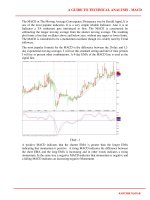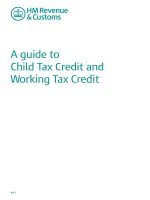20 CFO a guide to strategic transformation
Bạn đang xem bản rút gọn của tài liệu. Xem và tải ngay bản đầy đủ của tài liệu tại đây (983.53 KB, 72 trang )
The 80/20 CFO
How to Make Strategic
Transformations in Your
Company
Janice Berthold & Suzy Taherian
courtesy of:
The 80/20 CFO
Independently Published
Copyright © 2018, Jan Berthold & Suzy Taherian
Published in the United States of America
180620-01122-1-2
ISBN: 13: 978-1790707874
No parts of this publication may be reproduced without correct attribution
to the author of this book.
For more information on 90-Minute Books including finding out how you
can publish your own book, visit 90minutebooks.com or call (863) 318-0464
Here’s What’s Inside…
Introduction...............................................................1
What’s Critical in the First 90 Days....................4
Helping the Board be an Effective Coach ...... 13
Inspiring the Talent on Your Team ................ 18
Getting Comfortable with the Financials ...... 24
Initiating Change in Your Organization ........ 33
Successful Fundraising ....................................... 38
Creating and Maintaining a Partnership
with the CEO............................................................ 42
Selling and Leading Change ............................... 47
Working Internationally .................................... 51
Quantifying and Reducing Your Risk ............. 56
The Risk Management Assessment ................ 60
Here’s How to Make Strategic
Transformations in Your Company ................ 63
About the Authors................................................. 65
Introduction
The 80/20 CFO!
You may be asking yourself why this book is
titled The 80/20 CFO and why it is co-written by
someone who is not a CFO.
Allow me to explain. The 80/20 rule was
formulated in the late 19th century by the Italian
economist Vilfredo Pareto. The “Pareto
Principle” came from his observation that
roughly 80% of the effects come from 20% of the
causes.
Likewise, only 20% of the work creates 80% of
the outcome. While the numbers may not be spot
on, the theory holds true in pretty much
everything we do. This principle can apply
whether you are working with a client,
networking with potential investors, closing the
books, or putting together a reporting package.
As the financial leader of your company, it’s
important to know, not only, what work results
1
in bigger and better outcomes; but what work
takes up the most time without providing the
highest results. Our goal with this book is to
provide the “Cliff Notes” to efficiently move the
needle toward the biggest results for your
business.
As mentioned earlier, I am not a CFO, but I have
worked with many over the last 30 years. I have
also started, and co-moderated four invitationonly CFO groups to improve results
performance.
The CFO’s job is one of the loneliest on the
planet.
Our invitation-only groups help CFOs make
better decisions, in part by, relieving the
isolation they may feel when making important
decisions. This process gives us the unique
opportunity to provide them with unbiased
opinions, so they stay focused on their key
initiatives.
Lastly, I’m thrilled to be partnering with an
amazing CFO, Suzy Taherian, an experienced CFO
and adjunct professor of International Business
at the University of California at Davis. I’ve
observed her work with three different
companies and witnessed the incredible results
she gets.
Suzy is going to share her insights on important
topics like, how to interact with the Board, how
2
to sell change, how to partner with the CEO, and
how to mitigate a company’s exposure to risk.
We hope you enjoy the book!
It’s not every day we are fortunate enough to
have a successful CFO take the time to articulate
the skills and strategies they use; to get more
done by doing less and the secrets to looking like
a hero while transforming your organization.
Sit back and listen as I interview Suzy on the
mindsets she’s cultivated and the game plan
she’s implemented, being a leader of strategic
change within an organization.
Our hope is to inspire you to be a greatly
successful CFO, to enjoy your work, with the goal
of sharing what you learn along the way so you
too can mentor those coming up. And, if this
book helps you avoid some of the mistakes we
made, then all the better!
To your success!
Jan & Suzy
3
What’s Critical in the First
90 Days
Jan: Suzy, what do you recommend a new CFO
do in the first 90 days, to set the stage for later
success?
Suzy: Jan, that’s a great question. When I look at
a new job and begin organizing the first 90 days,
I like to think of what a friend once said to me,
“What would Carlos say?”
I had just started a job in South America and on
my very first day one of my new employees,
Carlos, walked into my office and said, “I’ve been
working in this company, at this location, for 15
years. I know the business. I know everyone and
everyone knows me. I know the country and I
speak the language. I really wanted this job, and
yet they gave it to you. You don’t know the
country. You don’t speak the language. Why did
they give this job to you?”
4
It was a very awkward conversation, but I
thought to myself, “He’s right. I don’t know why
they gave me this job. He sounds like he’s far
more qualified than I am.”
It was a good question, and I’m glad he asked it
because I suspect everybody else was thinking
the same thing. But Carlos was the only one who
was direct enough and honest enough to say it to
my face. It made me think, “What is it I bring to
this job? Why was I selected for this position
over other candidates?”
When I start a new position, I always think,
“What would Carlos say? Why did they pick me
for this job?” It makes me take a step back and
focus, to ask myself “What are the needs of the
organization, and the unique skills and abilities I
have that can add value and make an impact? It’s
important to tie it back to the overall strategic
goals: What are the key strategies of the
company and how do I support those?”
Jan: How do you differentiate yourself compared
to your predecessor?
Suzy: I focus on where the need is and leverage
my unique strengths to quickly make an impact.
When I’ve been hired as a new CFO, I’ve always
gone in after very strong, qualified, hardworking
CFOs, but the experiences and skill sets I brought
were different than theirs.
Here’s a great example. I was brought into a
company where the CFO before me had been
5
very strong in financing and banking
relationships but had poor accounting and
systems experience. They tried to implement a
new accounting system but had failed. Their
strategy was to improve operations by using the
new accounting system to improve performance
tracking and visibility. The biggest need they had
was to fix the accounting system and get the
financial reporting back on track, so that’s where
I put my focus.
In another situation, I came in after a very good
controller-type CFO, but there was no one with
banking and finance experience. A key strategic
initiative was to grow the organization with
additional investment They needed someone to
do fundraising and bring in additional debt, as
well as build banking relationships, so that’s
what I focused on.
Jan: How do you determine what are the key
priorities?
Suzy: When I come into a job, I immediately seek
stakeholder input. I talk to all the key
stakeholders to better understand the strategic
objectives and what they think the critical areas
are. This gets me focused very quickly. I also ask
them where they see my skill sets adding value
and why they picked me for the role. This
conversation is crucial to make sure I bring those
experiences and abilities to the job.
The key stakeholders are the Board and the CEO.
However, I also reach out and talk to the
6
leadership team: head of marketing, head of
legal, head of operations, the different critical
leadership roles, to better understand what their
perspective is and what they’re looking for from
the CFO, or what was lacking from the previous
CFO. One of the most important steps at the
initial stage is to quickly reach out to the
stakeholders.
I also reach out within the financial organization
to see who the controller or treasurer is.
Sometimes I ask for the organizational chart to
assist me with identifying who’s who. Those are
the people I talk to within the organization.
Something I learned from experience is that
some important people are not at the top of the
organizational chart, but they are thought
leaders or major influencers, or have the
historical perspective and institutional
knowledge that can benefit me. I reach out to
them to understand what’s going on within the
organization.
Jan: What is the objective in reaching out to the
stakeholders?
Suzy: There are two key objectives in the
conversations with stakeholders: 1) Getting
input from the people who have been there and
building an understanding of what they see the
need is, and 2) Building credibility and
relationships, which is the incubator for
alliances; a crucial component in influencing
change within an organization down the road.
7
I give them a sense of what my working style is
and the experience I bring, I’m very open and
curious to learn from them. Having this type of
communication expresses that I have something
to contribute, and, at the same time lets them
know that I want and need their support. The
key components here are the stakeholder
engagement, aligning on the strategic direction,
understanding the critical needs and what they
think I bring to the organization, and building
credibility.
Once credibility is established, it’s critical to look
for quick wins, because 90 days is not a lot of
time. Coming into a new organization there are a
lot of things we need to make happen. Therefore,
if we can hit a couple of quick wins in the
beginning, it helps build credibility and support
for doing more beyond that.
Jan: That’s sounds like a sound strategy, but how
do you get those quick wins?
Suzy: One example I love to bring for getting
quick wins is working with Heffernan, who has
been a fantastic partner for me in building
credibility. When I go into a new role as CFO, I
always reach out to you, Jan, our insurance
partner and say, “Look at our risk situation and
tell me if it has been well-managed.”
This technique has been a phenomenal success
because your team at Heffernan comes in and
gives me some great advice. Very quickly, I can
identify areas of risk that had been missed, that
8
could have been mitigated, and ways to save
money in areas where we have been overinsured.
Within the first 90 days I now have a good
assessment of our risk situation and can make an
impact with some quick wins. This all spells
credibility and gives me the support and
momentum to accomplish other changes. That’s
been a great quick win for me.
Communicate the Quick Wins
By doing this you are letting people know what
you bring to the table, what you plan to do, and
how it’s going to impact the organization. As we
hit those milestones, they see what we are trying
to deliver is delivered. This helps the new CFO
build trust within the organization as we go
forward. A lot is happening in those first 90 days,
but it all goes back to the question, “What would
Carlos say? What would Carlos ask me,” and
trying to answer the implicit question within the
organization, namely, “What’s this new CFO
capable of doing, and why would they select her
for the role?
Jan: By the way, how did the story with Carlos
turn out? Were you successful in that
organization?
Suzy: Carlos and I became good friends, and his
guidance as a stakeholder was invaluable. I
learned from him that the company had been
9
very inward-looking for many years, and a key
strategic initiative for that company was to
leverage global best practices around the world
at other companies in order to build a worldclass organization. The unique skill I brought
was my extensive international network and my
understanding of financial processes in other
locations and other companies.
Set Key Performance Metrics
I quickly reached out to contacts in other
countries to develop a list of 16 key metrics to
drive our performance. Based on my research
with other high-performance companies, we set
challenging targets for each metric. We started
closely tracking the metrics and celebrating
successes weekly. Quickly the organization
began to see how it compared to other
companies in other parts of the world and how
we were making measurable progress towards
becoming world class. While results improved, I
was very pleased to see that morale and
productivity improved as well. With clear
quantified objectives, employees were getting
recognition for delivering on impactful activities
so they focused on high priority activities. This
eliminated frustrations with wasted time and
efforts on non-core activities. Overtime hours
went down. Our company quickly gained
recognition for its high-performance culture. I
was able to secure promotional opportunities for
10
several team members, including Carlos, in other
global assignments. Today Carlos is still a good
friend and he’s actually in my former job, the
position that he had always wanted.
Jan: Clearly setting up the right metrics was
really important in quickly driving performance
in the first 90 days. Numbers and metrics and
analysis are important to all CFOs. But as you
mentioned, dialogues with key stakeholders are
also critical in those first 90 days. How do you
prioritize whether to focus on analysis or reach
out to talk to people?
Suzy: Analysis gives the insight on where the
problems are; talking to people builds the
consensus to solve those problems. Many CFOs
tend to be very strong in analytics and financial
analysis, so they will ask for the numbers and sit
in their room pouring through the financial data.
This is helpful, but there’s a lot of stuff buried in
there that may not pop out at them.
Without having all the conversations I covered
earlier, they may be missing the critical needs
within the organization. They’re also missing
building those relationships and getting buy-in
and letting people know about themselves and
their credibility. They are missing a golden
opportunity.
In one case, when I was the new CFO, the person
before me had not reached out within the
organization, so people came to me and said,
“We didn’t know this person, we don’t know how
11
they made decisions. We didn’t always support
what they did because we didn’t know where it
came from.”
I realized the person before me had been a
brilliant mind but hadn’t done a good job of
building relationships. When they went to take
the initiative and act, there was no support from
within because people may not have agreed with
them on the high priority items or understood
where the decision was coming from.
The natural tendency for many CFOs is to bury
themselves in their office and stare at the
numbers. A much more effective strategy is
going out and talking to the stakeholders to build
credibility and relationships. If you don’t get that
accomplished you will be attempting to make a
change within the organization, without support
or credibility, and that makes it very, very tough.
That’s why I have seen a lot of CFOs fail and exit
very quickly. If you see a CFO who’s only been
there a year or two and is then asked to leave,
it’s often because of that. They came in and tried
to change something that didn’t need to be
changed, or something did need to be changed,
but people weren’t aligned with them on that
goal. The poor CFO ends up being out on a limb
by themselves.
12
Helping the Board be an
Effective Coach
Jan: What recommendations do you have for
interacting with the Board?
Suzy: The relationship with the Board is like the
roles in a football game. The Board is the coach;
the CEO is the quarterback; my role as CFO is
part statistician (to provide the analysis and data
of the plays they’re considering), and part
cheerleader, to bring everyone together around a
shared vision and push to persevere to realize it.
The role is also part announcer, to update key
stakeholders (shareholders or analysts) on the
successes and how the team is progressing
towards the end zone.
It’s important to have the Board align around a
key vision and clearly communicate that to the
CEO and CFO. Then the executive team and the
Board should align on the strategies to achieve
that vision. The whole team should be working
13
off the same game plan. What I find useful is to
build a relationship with the Board by using a
strategic planning process.
Strategic Planning Process as a Board
Alignment Tool
Anywhere I’ve gone, I’ve encouraged the
organization to go through a strategic planning
process. And that means asking the hard
questions:
What are we going to do in the next three
to five years?
What’s our assessment of the current
market?
What’s our assessment of the future
market?
What’s our competitive strength, and our
ability to grow and beat the competition?
It’s a great way to have a dialogue with the Board
and to understand what their vision is, where
they see the organization, and how they want to
challenge it. That’s a very natural conversation
and the outcome is very good. But the process is
also good because it helps alignment to occur;
everyone’s on the same page, where they want to
go, how fast they want to get there and how they
want to get there. It also limits wasted energy on
minor topics that don’t have strategic impact.
Jan: You mention asking the hard questions from
the Board of Directors. Why are these questions
14
difficult? How do you help the Board align on the
answers?
Suzy: To be effective, a good Board should have a
diversity of opinions; but that sometimes makes
it difficult to get alignment. Open communication
is a great way to build a relationship with the
Board. It’s not always an easy quick
conversation. Different Board members bring
different experiences and may have different
agendas. Sometimes different Board members
have different perspectives and it could be
different from what the CEO wants to do.
The Data will Show the Way
To help the Board and CEO align on the right
strategies, my role is the statistician: I make sure
everyone has the same data. Good analysis can
help clarify which strategies have a higher
probability of success. The insights about the
organization’s performance can help the Board
make better strategic decisions and ultimately,
they’ll be better at coaching the team.
During the 2008 global financial crisis, I
developed detailed financial models for our $4
billion organization. It was a dynamic model so I
could meet with the Board and test different
scenarios and sometimes model the outcome in
real time. I also try to make sure I come with
different proposals so the Board and executive
team can consider some alternatives. Robust
15
market and competitive data are also helpful so
they can stress-test the plan.
In my announcer role, I keep the board abreast
of our progress or obstacles so they can
determine if we need to fine-tune our game
strategy. During those turbulent days, I was
giving weekly updates to the CEO and the board.
We would have to make adjustments to our
plans as we saw key changes in the market. We
tracked leading indicators to predict financial
outcomes and make decision quickly.
And as cheerleader, I’m supporting the CEO, our
quarterback, to believe we can achieve the goal.
The CFO is often the sounding board for the
Board and CEO. We need to listen and give
positive reinforcement. This can be difficult for
many CFOs as we tend to be risk-averse with
strong analytical skills so we can quickly identify
the risks in any situation. While the Board
appreciates that objectivity, it can come across as
pessimistic over time. One way to address that
is to identify the problem but also recommend a
solution.
Don’t say why it won’t work; advise how it
could work
In one situation, the Board asked me to evaluate
a potential strategy to launch a new technology
with a $100 million investment. My analysis
showed that it would be unprofitable. But
instead of going back to the Board with that bad
news, I redid the analysis with different
16
assumptions, such as pacing capital expenditures
with modular design, minimizing overhead,
leveraging other technology, putting laser-focus
review on cost and pricing assumptions,
identifying government incentives for R&D,
looking at possible tax advantages, exploring
creative financing options, etc. I even contacted
some financing sources to validate the
assumptions. I presented the final analysis and
showed what was possible. The Board was very
pleased and we shifted strategy towards the
alternative approach.
I find if we get everyone through the strategic
planning process and provide good analysis to
get everyone aligned, it reduces the questions
and friction down the road. It’s a very useful
process.
Ultimately, the Board, the CEO, and the CFO are
working together in their different roles to drive
strategy for the company. The strategic planning
process helps clarify the roles and keeps the
focus on driving strategy.
17
Inspiring the Talent on
Your Team
Jan: How do you assess and manage your team?
Suzy: This is one of the things we do really
quickly when coming on to a new team, and my
story on this is what I call…
Find Dave in Minnesota
When you come to a new organization, you
inherit a team. I get the organizational chart so I
know who’s who and I try to meet with the team
on a weekly basis. I put together some Key
Performance Metrics to give my team a way to
communicate with me and to know how I
measure their performance. I try to connect their
performance metrics with the strategic
objectives. We’re always trying to keep the
organization focused on the strategic direction;
tying performance feedback and accountability
18
to strategy is a great way to align the team and
set the right incentives.
It helps define their roles, “Here are the key
objectives, here are the key metrics, and here’s
what I expect you to do.” It not only guides each
team member to better understand their role,
but it also helps me assess their performance
against those goals. I find that sometimes the
formal processes and formal organizational
charts may hide unsung heroes.
This is where Dave in Minnesota comes in.
In every organization there’s a guy like “Dave in
Minnesota.” I discovered him a few years ago. In
this particular organization, the accounting
system wasn’t working well, and as a result we
were suffering. The operations folks didn’t know
how they were doing because the accounting
system wasn’t working.
I had a comptroller and a treasury person, but
the comptroller quit, so I was stranded with no
accounting system and no comptroller. I was
running blind. But as I talked to different people
in the organization, they kept saying, “Well, call
Dave in Minnesota. He’s got some good
numbers.”
I heard the same thing from a few different
people, but they said it was not our biggest
location. We had plants all over the country, and
Minnesota was a smaller office. Dave didn’t show
on the organizational chart as a senior person.
19
But I did call him and found out very quickly that
Dave, out of his passion and interest, had
methodically and consistently been tracking the
data across all the plants for several years.
He had spreadsheets tracking production data,
cost data, revenue data, and pricing. It was
amazing how much data analysis this guy had.
He intentionally had a full, robust accounting
system he was running outside of our normal
accounting system, which wasn’t working.
He was a brilliant guy. He didn’t have the kind of
pedigree you’d normally expect for a senior
finance person, but he was incredibly smart,
hard-working, very knowledgeable, and very
well-respected within the organization.
I talked to Dave and found myself relying on him
more and more. When we put in a new
accounting system, we validated the data in our
accounting system with the figures in Dave’s
spreadsheets. It’s not common to find somebody
with a trove of data, but I found it’s very common
to find people within the organization who are
unsung heroes who have done great work or
have institutional knowledge who are severely
undervalued.
I offered him the job as comptroller in California.
He said to me, “Suzy, I don’t want to move to
California, my family’s here.” I said, “Okay, fine.
Work from Minnesota, and we’ll do it virtually.
Fly in one week a month to California.” We gave
him a raise and it worked out well for the
20
organization because the cost of living in
Minnesota is much lower than in California.
Here's the great thing. Without paying a
recruiter fee, without paying a relocation fee, we
had found someone within the organization who
could step into the comptroller role. It was a
bonus that he had the trust of the organization
and for a lot less cost than if we went out and
recruited a person in California. Dave was a
lifesaver.
Jan: How do you connect with your team?
Suzy: My beginning protocol always include:
Chatting with people across the
organization so I can meet as many
people as possible informally. I like team
lunches or one-on-one lunches to get to
know them and build relationships.
Having weekly meetings so I can get
good insights from people I’m working
with, more formally. Like most CFOs, I’m
data-driven and like performance
metrics so weekly meetings are great for
tracking data and quantifying progress.
It gives a team an understanding of my
workstyle.
Looking for people I can promote from
within to recognize high potential strong
performers. Often organizations will be
nervous with a new CFO because he or
she will bring in their own team and
21









